Results & Discussion
Demographics
The Capture-Mark-Recapture study resulted in 1306 marked unique individuals with a 33% recapture rate. Out of these individuals, 75% were male and 25% were female. While this might make it seem like there was a male biased sex ratio, it is likely due to behavioral differences between males and females, where males are more visible and fly more.
Using Craigs Estimator, a rough population size was estimated for the area of Filehajdar. The estimated population size was 2363 individuals. However, this estimate should be taken with a bit of caution, as Craigs Estimator is more often used to get a rough idea from a smaller sample size than the present.
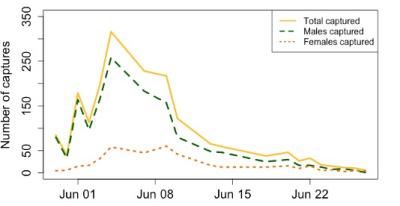
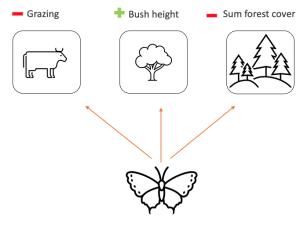
Habitat preference / Adults
Adult density was lower in grid cells that were grazed and with a higher forest cover. Hence, while adults preferred a more open landscape, grazing, which is a common method to maintain a low vegetation cover, in fact seemed to reduce the habitat quality. This is likely a consequence of a lower abundance of nectar resources followed by grazing. However, it could also be a consequence of decreased larval survival in grazed habitats, which will be discussed more later.
Adult density was higher in grid cells where the mean bush height was higher. The importance of bushes might not be so intuitive for a grassland species. However, studies on other species of butterflies with a preference for open landscapes have shown that structural elements, like bushes, are important for roosting and mate location, as well as for wind protection. Thus, while open areas are essential, presence of some bushes are important as well.
Habitat preference / Egg-laying females
Females were more likely to lay eggs where host plants were larger and more abundant, which was expected as large host plants and a high host plant abundance both have been shown to be important for larval survival in previous studies. Females also preferred host plants with a lower degree of tree crown cover in a southern direction and with less grass cover surrounding them. These results suggests that females avoided host plants in more shaded conditions, despite host plants being present there. With more sun exposure reaching the host plant, temperatures may rise more quickly, which stimulates larval development.
Females also preferred to lay eggs where large tussocks were present. The importance of tussocks may simply be that host plants on tussocks are easier to detect for the female, given that the other vegetation on the tussock is low. However, this preference may also be to decrease the risk of their offspring drowning during floods. And further, the microtopography from a tussocky landscape may result in different microclimates, which, for example, may help buffer against unfavorable conditions.
Altogether, it seems that while characteristics of the host plant, such as size and abundance, are important – so is the microhabitat surrounding the host plant. Hence, females seem to choose host plants to increase the survival of her offspring.
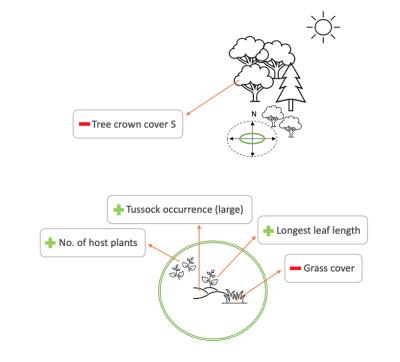
Habitat preference / Larvae
As the location of larvae is largely dictated by the choice of the female due to the relative immobility of larvae, larval colonies were found in a similar environment as the egg batches. That is, were host plants were large, where there was less grass surrounding the host plant and where tussocks were present. This implies that the choice of the female indeed positively affected larval survival.
However, larvae also occurred more often on host plants that had more stalks. A couple of possible reasons for this are that (1) stalks are important to avoid flooding during the wetter months and (2) stalks are important for nest building. Larvae in this, as well as in other studies, have been seen using stalks for building their nests.
Larval density was lower in grid cells where mammalian feces was present, which likely represents the effect of grazing. In another study in the same area, larval density was five times lower in the grazed habitat due to poor habitat quality, with smaller and fewer host plants.
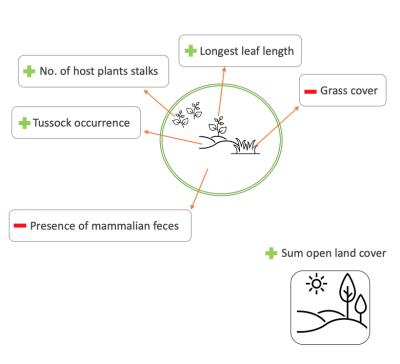
Larval survival
By the final visit, 60% and 70% of the larval colonies were alive in the habitats of Filehajdar and Kallgate ungrazed whereas only 10% were still alive in Kallgate grazed. It was suspected that at least 6 out of 10 of the followed larval colonies in the grazed area of Kallgate had been grazed by cattle. This suspicion was based off the signs on the host plant and its surroundings, which could indicate grazing activity, sometimes together with other signs of cattle presence, such as feces. However, the cause of larval mortality was difficult to assess with certainty, and on some occasions, the eggs or larvae had simply just “disappeared”.
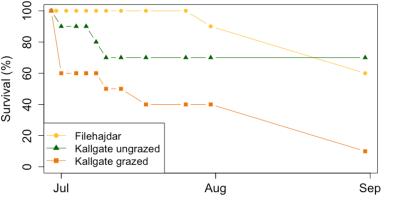
Responsible for this page:
Director of undergraduate studies Biology
Last updated:
06/08/21
